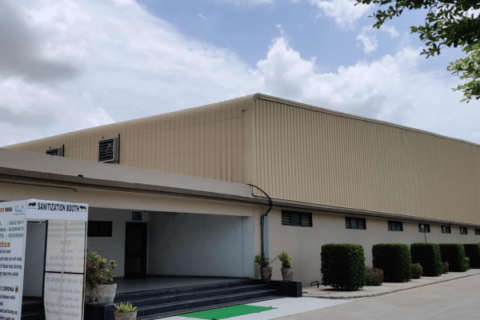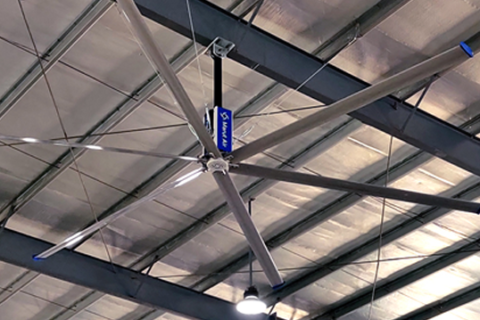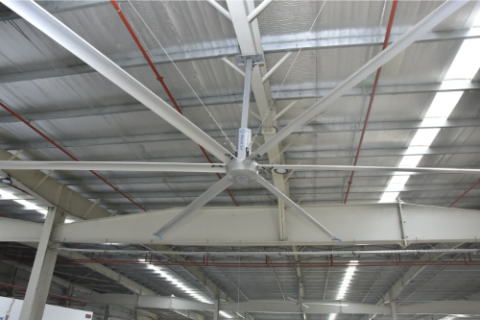Need for HVLS Fans in Chemical Processing Plants
In chemical processing plants, high temperature, fumes, and humidity are some common problems. In such plants, consistent airflow is required so that the odor of harmful gases or chemicals does not accumulate. Dust, humidity, and temperature fluctuations may impact the production quality, along this worker safety and comfort will be compromised. Ordinary fans or traditional exhaust systems cannot ventilate large space properly. That is why HVLS (High Volume Low Speed) fans are perfect for this scenario, as they circulate air gently and efficiently over a large area, while reducing the energy consumption.
Marut Air is one of the top HVLS fan manufacturing companies in India. This company has been providing advanced ventilation solutions for industrial premises since 2016. They always focus on delivering customized, energy-efficient, and low-noise air movement solutions, which come with quality assurance. Marut Air’s HVLS fans are manufactured as per industry standards, whether it be a city or remote location, they offer their reliable service everywhere. Their customer-centric workflow, site analysis, and quick execution keep Marut Air ahead of other brands.
How Do HVLS Fans Work?
The primary principle of the HVLS fans is less velocity, more air. These are the types of fans of large size with aerodynamically designed blades like helicopter blades. When these fans run at slow speeds, there is a higher amount of air moved around in the shape of a light breeze that covers the entire area. This equalises the temperature, eliminates fumes and bad air and also controls the humidity. Their motor is direct, and this enhances energy consumption, and maintenance is practically zero. These fans can be applied during both summer and winter seasons, reduce costs spent on operation and enhance security.
Frequently Asked Questions on HVLS Fans for Chemical Processing Plants
Q1: Why are HVLS fans installed in chemical plants the most?
Answer: Chemical plants involve control of chemicals, fumes and temperature. HVLS fans evenly distribute air, which makes the temperature constant, the quality of the air unchanged, employees receive a fresh atmosphere, and production is safe. The fumes and odors are also diluted by these fans and, as a result, the working area becomes safer and easier.
Q2: Why are Marut Air HVLS fans energy efficient?
Answer: Marut Air HVLS fans better move air at a low speed, with fewer watts of electricity, and greater coverage. A single big HVLS fan is capable of replacing 10-20 standard ceiling fans; thus, the cost of running them is minimized. They are low noise and offer long-term savings.
Q3: Are HVLS fans an easy thing to install and maintain?
Answer: Absolutely! Marut Air HVLS fans installation is very easy. Site survey is done, and then a customized solution is offered by the team. They are gearless and direct-drive, which does not require much maintenance and features a long life warranty. It does not require regular servicing.
Q4: How do HVLS fans manage to control harmful gases and chemical odors?
Answer: Since HVLS fans use the high air volume, low speed technology, air constantly circulates across the area of the plant. This avoids stagnation of air and accumulation of fumes, doused toxic gases and keeps the environment tidy at all times.
Q5: Will HVLS fans apply effectively during summers and winters?
Answer: Yes, HVLS fans cause a cooling effect during summertime since the airflow helps to reduce the temperature. These fans also ensure the warm circulation of the air in winter, which lowers the cost of heating. They offer a year-round advantage because of the dual use they offer.
Q6: What is the customer service and working system or style of Marut Air?
Answer: Marut Air deals with each project in a differentiated manner. Off the shelf solution, the consultation, On-site examination and post-installation support are provided on demand. The team has not compromised on the subjects of transparency and good quality, because of which it continues to produce a high measure of satisfaction among clients.
Q7: What are the alternatives to the HVLS ventilation option, and why is HVLS the best in the chemical processing industry?
Answer: Conventional ventilation, like small fans or exhaust fans, moves air to move up to a certain length of the area with atrocious amounts of noise and high consumption of power. HVLS fans, being even and silent devices, are sustainable solutions, affordable and also help release uniform air flow throughout the facility. HVLS is therefore suitable when it comes to safety, comfort and efficiency.





